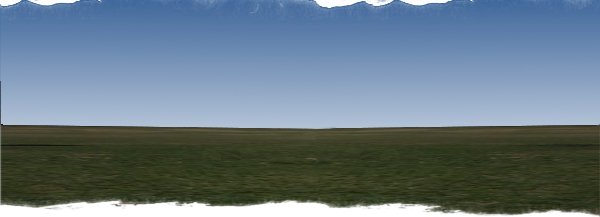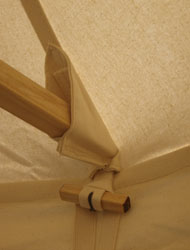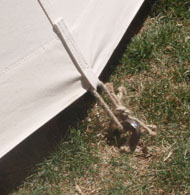Tent Styles
Details
Set-Up Instructions
Quality?
Naturally, I use top quality canvas and first rate sewing techniques in making my tents. However, the same can be said for any of the major manufacturers. I'll be the first to tell you that my competitors make a quality product. So... If not for an advantage in quality, why live in a Fritz?
For me, it comes down to Craftsmanship, Attitude, and Details.
Craftsmanship
I really do "craft" my tents. While machinery is involved, I use a lot of hand tools in the fitting and finishing stages. For example, the rounded ends of spokes on hub and spoke pavilions are rounded by hand, with a drawknife. Why?... because it makes a difference in the feel of the thing. You can tell when you handle it that it was made by hand. It's got spirit, and it wouldn't if I did everything with some automatic machine.
Attitude
Since the Victorian age, there has been a conceit that, while romantic, the medieval times and people were not particularly bright or practical. And that now, in this enlightened time, we are so much smarter and better at everything than those who came before us. That while we can romanticize about the spirit of the age, we should pity (or rather patronize) those who actually had to live in days gone by.
On the contrary, medieval people were the same Homo Sapiens as we are, genetically indistinguishable. They were not stupid, nor did they see themselves as romantics. Economics were just as hard a reality then as now. If it worked, it got kept; if it didn't, it went by the wayside. For us, this is a hobby, for them, it was real life. Also, for any given task, or craft, there were a lot more of them trying to figure out the best methods than there are of us. Therefore, when trying to accomplish something, it is often best to first try to figure out how it WAS done THEN and then make appropriate adjustments for our current conditions.
For example, I use a sewing machine because current conditions make it prohibitively expensive for me to spend a thousand hours hand-sewing a tent. On the other hand, I finish all my wood with a linseed oil and beeswax based natural penetrating oil finish. This was a very common wood finish all the way until a few decades ago. It also happens to work well and be very easy to touch up. When polyurethane goes bad (which it eventually will) you must strip it back to bare wood and reapply from scratch. Linseed oil will slowly fade over time. When you feel you want more protection, just wipe on a light coat with a rag and let it dry. Viola! It is done.
I spend a lot of time trying to figure out how the originals were made. I then replicate those methods to the best of my ability. The result is that you end up with a more authentic object, inside and out, without sacrificing ANY functionality.
Some tent makers seem to think that tents only need to look good from the outside. I think that one of the major reasons people buy pavilons is to give themselves a more authentic experience. Your "medieval moment" shouldn't be broken by going inside your pavilion. It takes a little longer to craft the inside with the same care as the outside, but I think it's worth the trouble.
Details
For starters, all the wood parts are made from hardwoods, and are finished with a natural penetrating oil finish. Next, where steel parts are necessary, they are heat-blackend and waxed instead of galvanized. Why?... Because it's beautiful, durable, reasonably priced, and it doesn't knock you straight back into modern times when you see it.
Next, I make wooden toggles and loops for detachable walls and such. Why?... because medieval tents were made this way and, once again, who wants to be dragged into the 21st century by a bunch of chrome-plated spring clips? Besides that, toggles work really well. They're strong, secure, and easy to attach/detach.
After that, how about the most durable stake loops in the business?... One of my competitors claims to have the "strongest stake loops in the business" and, technically, they might be correct. However, strength is not the most important characteristic in a stake loop. As long as they are strong enough, the failure mode in stake loops is invariably chafe. They get worn, or even cut, by the hard edges of square iron stakes. I take this into consideration by making the wear point easily replaceable... in the field! No sewing machine necessary, just tie on a new little bit of rope. Actually, in practice, I've found hemp rope loops to be much more chafe resistant than the webbing loops used by other manufacturers. So, while my loops are very easy to replace, you'll also find yourself having to do it less often.
Then there are things like my guy ropes, which are real hemp. I splice an eye in one end, and whip the other, to keep it from unraveling. These are ancient techniques that are stronger and neater than knotting or, god forbid, duct tape.
| |
|
©2009, 2010, 2011, & 2012 Gene Eisele
Privacy Policy
Contact Me
|









